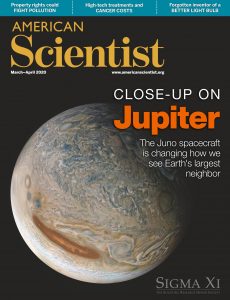
American Scientist – March-April 2020
English | 68 pages | pdf | 21.54 MB
Revealing the Invisible at American Scientist Magazine March-April 2020 Issue
The Juno spacecraft has been at Jupiter and collecting data since 2016, and it has been prompting astrophysicists to revise their perceptions of that giant planet since its first data return. An accurate characterization of Jupiter is important, not just because we want to understand that planet and its formation, but also because Jupiter was almost certainly the first planet in our Solar System. Astrophysical models show that when Jupiter formed, it took in more than half of the available matter, so its composition is a time capsule of the ingredients present in the early Solar System. Jupiter’s formation, and what it left behind, constrained how the rest of the Solar System—including our planet—came about. And there’s a whole class of extrasolar planets that have been discovered in other systems that are called “hot Jupiters” because our gas giant is thought to be a model for their structure and internal conditions. So if we have a wrong view of Jupiter, we won’t have an accurate understanding of these exoplanets either.
Scott Bolton, principal investigator of the Juno mission, describes in “Inside Jupiter” (pages 98–105) just how wrong we were about our largest neighbor, before Juno’s data began to set the record straight. Bolton has a long track record of working on space missions; indeed, he started developing the idea of the Juno mission while he was part of the Cassini mission to Saturn. On its way to the ringed planet, Cassini passed Jupiter, and Bolton says he petitioned for Cassini to be turned on to observe the gas giant during that distant flyby. That got him thinking about ways to image Jupiter’s interior, which is under far too much pressure for a probe to withstand. He and his team then developed the microwave imaging instruments that are now on the Juno spacecraft, which have gathered the data prompting scientists to revise our understanding of Jupiter.
But you don’t have to go to Jupiter to find innovation in imaging. In the medical field, imaging technologies that are faster, more detailed, and more precise are helping diagnose and treat serious diseases, particularly cancer. In “Cancer Care Is Getting Better, But Also More Expensive” (pages 106–113), Hannah McGillivray and Richard Wassersug discuss a field called theranostics—a combination of therapy and diagnostics—and the associated technologies that can simultaneously diagnose and treat cancers.
Technology is also revealing and capturing what would otherwise be invisible dangers to human health from our environment. For instance, air pollution can be a great unseen threat. But once it’s detected, how can the polluters be held accountable? In “How Property Rights Can Fight Pollution” (pages 92–97), Lawrence
B. Cahoon, Robert H. Cutting, and Michael A. Mallin describe how data and the legal system can be combined to use property rights in the fight for human health.
We hope you enjoy this issue of American Scientist Magazine. As always, your feedback is welcome to help reveal what’s invisible to us—your thoughts as you read these pages and what you find most interesting. —Fenella Saunders (@FenellaSaunders)
Download from: